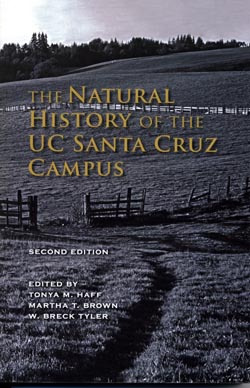Lunchtime walkers heading out into the redwood forests on campus may have noticed a strange thing over the past few weeks--a deafening sound, a buzzing, clicking, whirring clamor coming from high in the treetops, but with no discernible source.
What the heck makes that racket?
That campus conundrum and many others are demystified in a new edition of The Natural History of the UC Santa Cruz Campus, released this month. The book, lovingly assembled and packed with easily digestible information and more than 125 photos, drawings, diagrams, and maps, is full of "aha!" moments.
So--that clicking sound? On page 187, it's all explained. It's coming from male woodland cicadas, sending out their mating calls with "a cacophony of mechanical-sounding clicks." These little insects climb high into the trees, so that they're often heard but rarely seen.
Aha!
The second edition of The Natural History of the UC Santa Cruz Campus was edited by Tonya Haff, curator of the UCSC Museum of Natural History Collections; Martha Brown, Center for Agroecology and Sustainable Food Systems senior editor; and W. Breck Tyler, research ornithologist for the Institute of Marine Sciences. Bay Tree Bookstore, which acted as publisher of the book, has printed 3,000 copies, and hopes the book is popular enough to warrant another printing soon.
The trio worked on a new edition because the first edition, out of print for nearly 25 years, is hard to find, and there's no other easy source people can turn to for information about the natural history of the area, said Haff.
"This is so much more substantive, even though the first one was wonderful," said Haff, who raised more than $20,000 to cover the costs of the new edition.
"This is a quantum leap in terms of information," agreed Brown.
Dedicated to the memory of the late Ken Norris, professor of natural history and coordinator of the Environmental Field Program, the book covers human history, geology, plants, mushrooms, lichen, and animals.
The animal and fungus chapters are new; the history chapter is almost entirely new; and other chapters were amended from the originals. The editors updated the lists of plants and animals found here, and hired past and present students, including one from the UCSC Extension Science Illustration Certificate Program, to provide almost all new illustrations.
From banana slugs to bobcats, redwood groves to rolling meadows, caves to quarries, readers can learn about the campus's wealth of wildlife, geologic features, and cultural imprints.
The writers encourage active learning. For example, in a sidebar on "The Importance of Tule," they give the exact location, with map, of some tule, a grass-like member of the Sedge family: "Near campus, tule is in the Kalkar Quarry near Faculty Housing." The book also advises tule-searchers to "bring a knife to cut through the strong, outer skin so that you can examine the whitish, lightweight pith inside."
"I encourage people to be hands-on," said Haff. "I definitely encourage that kind of learning. Reading a book is fine, but there's nothing like touching, seeing, and smelling what you're learning about."
Edifying facts jump out of nowhere. For example, you can find out the source of the word "limelight" and--if you dare--learn about the startling sex life of banana slugs.
Freelance writers, staff, faculty members, undergraduate students, a graduate student, and a post-doctoral student contributed to the book, and it has back-cover endorsement from Edward O. Wilson of Harvard University and Paul R. Ehrlich of Stanford University--"biology gods," according to Brown.
Haff and Brown hope the book inspires curiosity, a love of the campus, and stewardship of campus lands. But also, they said, the volume highlights not only what we know about the campus, but what we don't--for example, why have the burrowing owls disappeared? And why do turret spiders build strange, castle-like structures at the entrance to their burrows?
"There's a wealth of research opportunities for students and faculty," said Brown.
And, she said, the information is relevant not only to campus but to the Santa Cruz Mountains region.
"So anyone interested in the region's natural history will want it on their bookshelf," Brown said.
The second edition of The Natural History of the UC Santa Cruz Campus is available for $12.95 at the Bay Tree Bookstore, and $2 per book sale returns into a fund for the next edition.
It will soon be available at bookstores in town, according to Haff.
Note to reporters: You may contact Tonya Haff at (831) 459-4763 or thaff@ucsc.edu; and Martha Brown at (831) 459-3376 or mtbrown@ucsc.edu.
Contact the author at gwenm@ucsc.edu.




